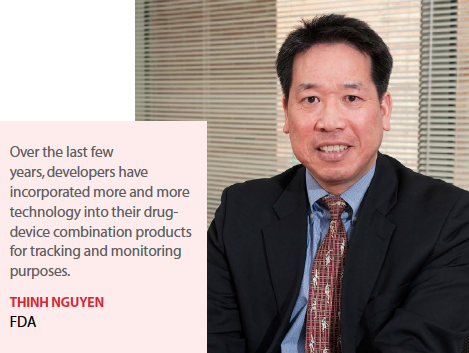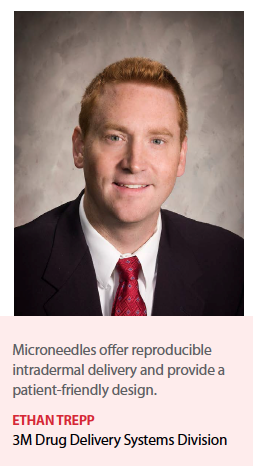Products that combine a drug or biologic with a device, such as drug-eluting stents and drug delivery systems, offer new approaches for treating disease, and these innovative drug-device combinations are expected to have a major impact in the coming years.
Researchers predict combination products will help patients suffering from cancer, heart disease, multiple sclerosis, cerebral palsy, spinal-cord injuries, anemia, hepatitis, rheumatoid arthritis, diabetes, and other serious diseases and conditions.
Drug-device combination products are likely to become more complicated as new technologies emerge and existing technologies mature. Next-generation devices are helping with the administration and delivery of therapies and new classes of biologics.
 “Newer drugs are being developed, especially in biologics, that have high viscosity and formulations that cannot be brought down to a single one milliliter dose, which would be a traditional prefilled syringe," says Eric Resnick, VP and chief technology officer at West. “These need unique solutions that consider the drug and how it needs to be contained. In other words, finding the right material to hold the drug so there is no incompatibility or stability issues is critical."
“Newer drugs are being developed, especially in biologics, that have high viscosity and formulations that cannot be brought down to a single one milliliter dose, which would be a traditional prefilled syringe," says Eric Resnick, VP and chief technology officer at West. “These need unique solutions that consider the drug and how it needs to be contained. In other words, finding the right material to hold the drug so there is no incompatibility or stability issues is critical."
Mr. Resnick says new devices are providing patients with treatments and solutions that can help them better adhere to their therapy.
Connected devices are one way that manufacturers are helping patients with adherence. These connected devices are also providing physicians with a better understanding of how patients are using a therapy.
Increasingly devices are becoming integral to product development. Experts say the devices of the future that are going to be the most successful are the ones that provide additional benefit over and above the product alone.
“Over the last few years, companies have increasingly incorporated technologies into their drug development plans resulting in drug-device combination products that include mobile apps and wireless capabilities for tracking and monitoring purposes and for improving convenience and or ease of use for patients or healthcare providers," says Thinh Nguyen, director of the FDA’s Office of Combination Products.
Combination products are therapeutic and diagnostic products that combine drugs, devices, and or biological products. Examples of traditional drug/device combination products include prefilled syringes (e.g., insulin auto-injector), drug coated devices (e.g., steroid coated pacemaker leads, antibiotic coated hip implants, and sirolimus eluting coronary stents), and co-packages (e.g., a syringe and a drug, or a first-aid kit containing bandages and topical antibiotics).
3M, for example, is developing a new kind of delivery system: microneedles. One of the company’s core technologies is microreplication, the ability to make consistent, very small profile structures. The company has applied this technology to the drug delivery space.
Ethan Trepp, global marketing manager, 3M Drug Delivery Systems Division, says microneedles work best for therapies that aim to trigger the immune system.
3M has two different systems in development: solid and hollow microneedles. The solid system contains microneedles that have been coated with the medication.
Currently, the solid microneedles are in a Phase II trial with a partner for osteoporosis.
 “When vaccines are administered with our solid microneedle technology, enhanced drug stability may eliminate cold chain storage requirements, extending savings to manufacturers and suppliers," Mr. Trepp says.
“When vaccines are administered with our solid microneedle technology, enhanced drug stability may eliminate cold chain storage requirements, extending savings to manufacturers and suppliers," Mr. Trepp says.
The hollow microneedles can reproducibly deliver a larger volume of medication to the intradermal layer of the skin, making it suitable for many biologics, which tend to be more viscous and require larger volumes per dose. The hollow microneedles have the potential to facilitate faster absorption and higher bioavailability of the drug than conventional injections.
3M is conducting Phase I trials of these microneedles with partners for immune-oncology therapies.
“As we develop these drug-device combinations, we want to ensure that the microneedles offer reproducible intradermal delivery, as well as provides a patient-friendly design," Mr. Trepp says. “Many in our industry may view the prospect of taking a new drug delivery technology (microneedles) and new APIs (biologics) through an already complex regulatory environment as a challenging endeavor."
Connected Devices
The emergence of connected devices — including inhalers and wearable sensors — and mobile apps present a wide range of new opportunities. GlaxoSmithKline, for example, is working with experts in digital healthcare technology, using tools such as adherence monitors, biosensors, and electronic diaries to better understand how medicines interact with patients.
In November 2016, Propeller Health, a digital solution for respiratory medicine, received FDA’s 510(k) clearance to market its Propeller platform for use with GSK’s Ellipta inhaler, the company’s dry powder inhaler. The sensor for the Ellipta inhaler was built and cleared as part of an R&D collaboration between Propeller and GSK that was announced in December 2015.
Propeller is FDA-cleared to help patients and their physicians better understand asthma and COPD, as well as to help to improve the symptoms of these chronic respiratory diseases.
With proprietary sensor technology, software, and services, Propeller’s digitally guided therapy platform integrates information from multiple sources, including connected medications, then uses machine intelligence to help individuals manage their condition.
Additionally, GSK is using the smart inhaler in its clinical studies.
Dave Allen, head of respiratory R&D, at GSK, says the company is planning a range of studies to explore various factors, including adherence, the impact on adherence of sharing data with physicians and patients, and the impact on the physician/patient relationship.
“An instrumented or a smart inhaler is simply a way to measure adherence in order to determine whether a patient in a clinical study has used the inhaler," Mr. Allen says. “This may not sound particularly exciting because patients could just write down when they’ve used the inhaler. But we know one of the difficulties, especially for clinical studies over quite long periods of time, is that people don’t always write down what they’ve done when they’ve done it. They may write it down at the end of the week. If they forget to take it for a day, they don’t generally write that down."
The smart inhaler, Mr. Allen says, captures the date and the time that it’s used, and the data are encrypted and submitted through a Bluetooth connection to a central server to the clinical study records.
“The adherence monitor on the inhaler is part of an integrated digital system," he says. “It’s a small but critical part of putting that patient-centric picture together in a clinical study."
Mr. Allen says the more people can be engaged in whatever activity is being measured, the more likely they are to do it. Positive reinforcement from activity trackers tends to lead to more activity.
“We’re fairly confident that these sorts of tools will lead to patients taking their medicines when they should," he says. “We can also start, hopefully, to illustrate the consequences when patients aren’t adherent."
Challenges of Drug-Device Development
The successful development of combination products presents regulatory, clinical, and technical challenges.
“It’s important that a company has systems, processes, and people in place to accommodate these changes because we don’t know what those changes are going to be," says Murray Malin, M.D., medical director, medical safety evaluation, AbbVie. “There will  always be new technologies that will affect drug/biologics and particularly device products."
always be new technologies that will affect drug/biologics and particularly device products."
He says there is a need for pharma and device companies, academia, and regulators to collaborate.
“It’s really important for all stakeholders, along with patients to work together to identify the best ways to ensure safe products get to the market quickly," he says.
AbbVie’s Duopa (known as Duodopa outside the United States) was approved by the FDA in January 2015 for the treatment of motor fluctuations for people with advanced Parkinson’s disease.
Duopa is administered using a small, portable infusion pump that delivers carbidopa and levodopa directly into the small intestine for 16 continuous hours via a procedurally placed tube.
Duopa was reviewed and approved by the FDA as a combination product with use of the CADD Legacy 1400 pump. Traditionally, this drug has been given subcutaneously or orally to patients. Through this new approach, the medication is delivered gastrointestinally through a GI tube.
Dr. Malin says the goal was to enable a more steady state dose delivery of Duopa to minimize fluctuations in symptoms in patients with Parkinson’s disease.
Stephan Gauldie, Ph.D., senior VP of strategy consulting at Back Bay Life Science Advisors, says companies need to think about the drug-device integration early rather than as an afterthought.
Dr. Gauldie says companies are struggling to understand the critical factors of a drug-device combination when it comes to regulatory review.
“Is it a drug or is it a device?" he asks. “This determination matters for the regulatory path and how the FDA reviews the product. There are different expectations in terms of the magnitude of information that is needed and a different likelihood of approval depending upon the regulatory path taken."
The FDA, he says, is going to be concerned about both the attributes of the drug and the attributes of the device. There might be additional information needed in terms of usability testing or safety.
“Success depends on the individual indication that a company is pursuing," Dr. Gauldie says. “It comes down to being able to articulate all the components — drug and device both."
Mr. Resnick says over the last five years, there has been greater awareness of the need to bring the delivery aspect of the program earlier into the process.
“Now you’re seeing the pharma and technology companies coming together as a product team and working well with partners during the planning stages," he says.
Regulatory Challenges
U.S. combination products are subject to regulatory review and oversight by one of three U.S. Food and Drug Administration medical product centers, with the Office of Combination Products providing oversight to the regulatory life cycle of combination products.
Over the last several years, the FDA has focused its effort on enhancing clarity and effectiveness of regulations for combination products by streamlining requirements while minimizing unnecessary burdens, Mr. Nguyen says.
Examples include the final rules on cGMP (current good manufacturing practice) requirements and postmarketing safety reporting for combination products.
Additionally, the FDA has developed guidance documents on combination products, including draft guidance on human factors studies and on the pre-RFD (pre-request for designation) process for obtaining informal feedback on product classification.
“Also the 21st Century Cures Act requires the agency to make changes to combination product review processes to enhance predictability and consistency and authorizes combination product sponsors, in certain circumstances, to rely on the FDA’s prior finding of safety and effectiveness or substantial equivalence to support marketing authorization for the combination product," Mr. Nguyen says.
FDA’s Office of Combination Products (OCP), created in 2002, aims to enhance the regulatory process by assigning combination products to the appropriate lead center. The office facilitates interactions between industry and FDA, monitors and adjusts processes to ensure timely and effective premarket review, and ensures the consistent and appropriate postmarket regulation of combination products.
In addition to combination products, OCP also has classification and assignment responsibilities for non-combination drug, device, and biologic products.
And in 2016, the FDA established the Combination Products Policy Council (CPPC), to help with modernizing the review process and improving communication between agency centers. The council also resolves disagreements among centers, the OCP, and/or sponsors on activities and policies related to medical product classification and the clearance/approval of combination products and cross-labeled products.
“The CPPC provides a senior-level forum for discussing, resolving, and implementing complex combination product regulatory and policy issues," Mr. Nguyen says. “The CPPC resides in the Commissioner’s Office and consists of senior leadership of the Office of Medical Products and Tobacco, CDER, CDRH, CBER, Office of Special Medical Programs, and OCP."
“When developing a combination product, pharmaceutical, biologic, and device companies are often faced with the challenge of rapidly understanding the regulatory requirements of the other medical components of their combination product," he says. “These challenges include which center is assigned as the lead to regulate the combination product, differences in application requirements, whether human factor studies are needed and how to conduct such studies, what other data are needed to support marketing authorization for the combination product, and the differences in review processes in the different medical product centers."
The FDA recommends that developers of combination products routinely visit the FDA’s websites to keep up with the latest FDA rules, policies (including guidance), and other actions with respect to specific combination products. Additionally, during product development, sponsors are encouraged to use the processes that have been put in place, such as presubmission meetings, to request feedback from the FDA. (PV)
~~~~~~~~~~~~~~~~~~~~~~~~~
Examples of Combination Product Approvals
Absorbable Collagen Sponge with Genetically Engineered Human Protein
Antibiotic Bone Cement
Biological Product Gel for Surgical Hemostasis
Cysview for Intravesical Solution and Photodynamic Diagnostic System
Dermal Collagen Implants for Aesthetic Use
Dermal Iontophoresis System
Iontophoretic Drug Delivery Patch and Controller
Iontophoretic Transdermal System for Fentanyl
Methylaminolevulinate Cream with Halogen Light Source
Paclitaxel-Eluting Coronary Stent System
Peginterferon alfa-2a in Combination with Ribavirin
Photodynamic Therapy
Sirolimus-Eluting Coronary Stent
Surgical Mesh with Antibiotic Coating
Tositumomab and Iodine I 131 Tositumomab
Source: Food and Drug Administration



















